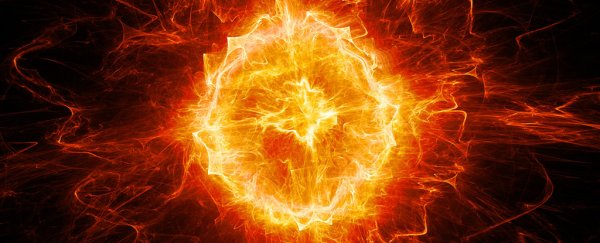For a brief moment earlier this year, a small spot in China blazed with such heat, the Sun would have been staring down at Earth feeling mightily jealous.
Scientists announced this week that the Experimental Advanced Superconducting Tokamak (EAST) reactor in Hefei has finally achieved a temperature exceeding 100 million degrees Celsius, setting a new record in fusion technology and bringing us closer to a new age in energy.
Harvesting the huge amounts of power released from the fusing of atoms is no easy feat. To throw these particles together with enough force, you need to either squeeze them hard, or slam them together with a mighty crunch.
And Hefei Institutes of Physical Science, Chinese Academy of Sciences has now shown this crunch is achievable.
Deep inside the Sun, hydrogen fuses together at temperatures of around 15 million degrees Celsius (27 million degrees Fahrenheit). That's with the added push of concentrated gravity.
If we want to achieve that on Earth, we need an oven that's a hell of a lot hotter. That is, nearly seven times hotter than the interior of the Sun. And then we need to hold that hot hydrogen soup in place long enough to make it worthwhile for producing energy.
If we can achieve that, the payoff would be massive. Unlike nuclear fission – where surplus energy comes from the decay of large atoms into smaller elements – nuclear fusion doesn't result in anywhere near as much radioactive waste. In fact, the end result of squeezing together isotopes of hydrogen is mostly helium.
Researchers around the world have been experimenting with different forms of technology that just might create enough heat to achieve nuclear fusion, which makes EAST just one of many facilities testing the limits of technology.
Some of the more promising approaches inject plasma into a giant metal doughnut, holding the cloud of charged particles in place with magnetic fields. This allows for sustained heating of the atoms, but requires some clever physics to keep the ring of plasma in place.
Stellarators, like Germany's Wendelstein 7-X, hold the squirming ring of plasma in place using banks of magnetic coils. They offer superior control, but struggle to hit those higher temperatures as a result.
Earlier this year the W7-X managed to heat helium to an impressive 40 million degrees Celsius. It's a big step up from previous efforts, but falls well short of the 100-million-degree-plus temperatures we need for that all-important fusion process to start.
Tokamaks like China's EAST reactor use the magnetic fields produced by the moving plasma itself to keep its wobble in check. This makes it less stable, but allows physicists to turn up the heat.
In 2017, the reactor celebrated an important milestone by holding plasma in a high energy confinement for 101.2 seconds.
Juggling hot atoms for this long was a vital step towards milking plasma for power, but now they had to turn the temperature up enough for its atoms to fuse and release more energy than the process consumed.
Getting the steps to line up takes a lot of experimentation and fine tweaking. EAST's procedure relied on multiple forms of heating in the right combination, creating an optimal plasma density.
The end result was a cloud of charged particles that contained electrons heated to more than 100 million degrees.
It's tempting to feel that we're tantalisingly close to a virtually endless supply of clean energy. And every milestone is a significant step towards that goal.
But there are still a number of challenges to meet. Take its fuel supply, for example.
Theoretically, the material feeds fusion reactions is in greater supply than fossilised hydrocarbons and uranium. It's plain old hydrogen.
Sadly, not just any kind of hydrogen will do right now – its isotope 'tritium' is preferred, and it isn't found in huge supplies. At least not on Earth.
Knowing how or when we'll overcome those kinds of hurdles is anybody's guess.
Still, hitting the right temperature was a big one, so it's worth holding out hope that fusion is still on the horizon.
Since its construction in 2006, the EAST reactor has been referred to as an "artificial sun". It's not unfair to say it might have been gloating all this time.
Now we can say it has truly earned its title.
